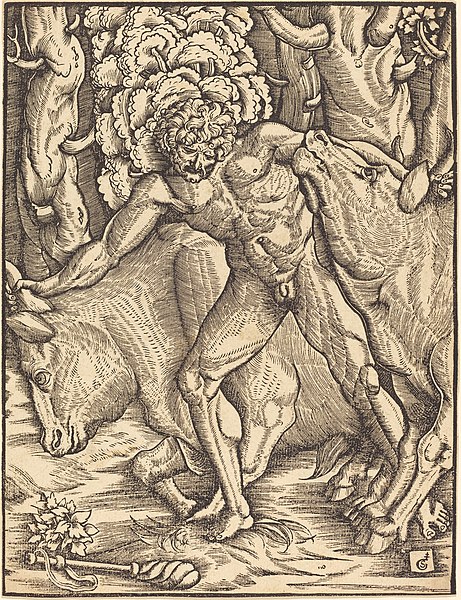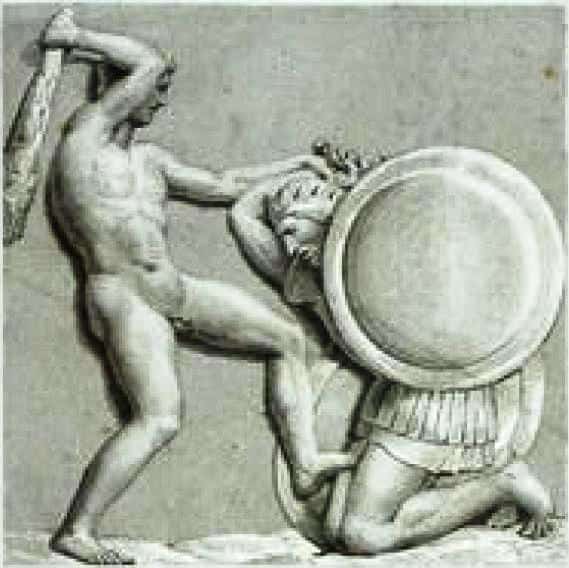Geryon’s Cattle, a herd of unmatched beauty and significance, have grazed the pages of Greek mythology, leaving an indelible mark on its rich tapestry. These aren’t just any cattle; they’re creatures that have witnessed the heroics of demigods and the whims of the divine. As we tread the pastures of their tales, let’s uncover the legends that surround these magnificent beasts and their guardian, Geryon.
Geryon’s Cattle Key Facts
| Origin | Island of Erytheia |
| Guardian | Geryon |
| Sought by | Heracles |
| Habitat | Pastures of Erytheia |
| Distinctive Features | Red-hued cattle |
| Associated with | Orthus, Eurytion |
| Symbols | Three bodies of Geryon, Heracles’ Tenth Labor |
Name and Etymology
Geryon’s Cattle, often simply referred to as the “Red Cattle,” derive their name from their guardian, Geryon. This herd, known for their distinctive red hue, were not just any cattle; they were the prized possessions of Geryon, a figure of immense strength and stature in Greek mythology.
The term “Erytheia,” the island where these cattle grazed, translates to “the red one,” further emphasizing the cattle’s unique coloration. This name, while simple, carries a weight of significance, tying the cattle to their guardian and their place of origin.

Geryon’s Cattle Origin and Creation
The tales surrounding the origin of Geryon’s Cattle are as vast as the pastures they grazed upon. These cattle, known for their distinctive red hue, were the prized possessions of Geryon, a formidable figure with three bodies. The island of Erytheia, located at the western edge of the known world, served as their home, a place where the sun set, and legends were born.
Guarded by Orthrus, a two-headed hound, and the herdsman Eurytion, these cattle were no easy prize. Their significance wasn’t just due to their beauty but also their place in the grand scheme of Heracles’ labors. They were not mere cattle; they were a challenge, a testament to the trials faced by heroes.
Geryon’s Cattle Encounters and Conflicts
The tales of Geryon’s Cattle are rife with encounters and challenges, each more intriguing than the last. Let’s delve into the most iconic confrontations involving these legendary beasts.
Geryon’s Cattle and Heracles Tenth Labor
Heracles, The Strongest Hero of Ancient Greece, known for his unparalleled strength and heroics, was tasked with obtaining Geryon’s Cattle as his tenth labor. This was no simple feat; not only did he have to traverse to the edge of the known world, but he also had to contend with Geryon, Orthus, and Eurytion.
With his indomitable spirit, Heracles faced each challenge head-on. He battled and defeated Orthus and Eurytion, clearing his path to the cattle. However, the final confrontation with Geryon was the most intense. Their battle was fierce, but Heracles, with his might and determination, emerged victorious, claiming the cattle and completing his task.
This tale, while a testament to Heracles’ heroism, also sheds light on the significance of Geryon’s Cattle. They were not just a prize but a symbol of the challenges faced by heroes and the lengths they would go to achieve their goals.
Depiction And Characteristics
Geryon’s Cattle, with their tales of beauty and challenge, have been depicted in various forms throughout history. Let’s explore some of the most iconic representations and characteristics of these legendary beasts.
Geryon’s Cattle, often depicted with a radiant red hue, are a sight to behold. Their distinctive coloration sets them apart from any other herd, making them instantly recognizable in art and literature. This unique hue, while simple, carries a weight of significance, tying the cattle to their guardian, Geryon, and their place in Greek mythology.
Nature and Behavior
The nature of Geryon’s Cattle is a blend of docility and significance. While they grazed peacefully on the pastures of Erytheia, their value and the challenges surrounding them made them a central figure in the tales of Greek mythology.
To the people of ancient Greece, Geryon’s Cattle were not just animals; they were a symbol of challenge and reward, a testament to the trials faced by heroes and the prizes that awaited those who succeeded.
Geryon’s Cattle Symbols or Associations
Geryon’s Cattle are often associated with various symbols, each carrying its own significance. The island of Erytheia, representing their home, is a constant in most depictions. The three bodies of Geryon, a symbol of his might and the challenges faced by Heracles, is another association that ties the cattle to their tales and significance.
Representations Of Geryon’s Cattle In Art
Geryon’s Cattle, with their tales of beauty and challenge, have inspired artists for generations. From intricate pottery designs to detailed frescoes, the cattle have been depicted in various forms, each capturing a different facet of their legend.
One of the most iconic representations is the vase painting showcasing Heracles’ confrontation with Geryon. This piece, with its vivid colors and dramatic composition, captures the tension and drama of the moment, showcasing both Heracles’ heroism and the significance of the cattle.

Mentions in Ancient Texts
The tales of Geryon’s Cattle have been documented in various ancient texts, each offering a unique perspective on the herd. From detailed accounts of their beauty to mentions of their significance, these texts provide a glimpse into the cattle’s place in Greek mythology.
One of the most notable mentions is in the works of Apollodorus, who provides a detailed account of Heracles’ journey to obtain the cattle. He writes, “Heracles, with his might and determination, faced numerous challenges on his quest, showcasing his heroism and the significance of Geryon’s Cattle.”
Frequently Asked Questions
Absolutely. Heracles, in his quest to obtain them, had to confront and overcome the two-headed hound Orthus as well as the herdsman Eurytion, and ultimately, the three-bodied giant, Geryon.
The cattle grazed on the distant island of Erytheia. A place situated at the western edge of the known world, often associated with the sunset.
Besides confronting Geryon and his guardians, Heracles had to journey to the edge of the known world. On the journey facing numerous obstacles and even creating landmarks like the Strait of Gibraltar along the way.
Obtaining Geryon’s Cattle was the tenth of Heracles’ Twelve Labors. The challenges he faced and overcame during this task further solidified his reputation as one of the greatest Greek heroes.
Featured Image Credit: Giulio Bonasone, Public domain, via Wikimedia Commons
